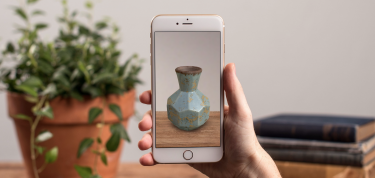
#ar #arkit #augmented-reality

07. Nov 2018 |
- min Lesezeit
Developing for AR in the past was always a pain:
Most of the pain points have been resolved by hardware improvements and great studios of Unity & Unreal Engine. But it has always been hacky and used mostly for marketing gags. Since the release of ARKit things changed greatly, there are many usecases coming up from big companies like IKEA or Amazon and some of them seem to finally solve real problems.

It is „easier“ for Apple to introduce new features at first, as they can directly calibrate their devices and have not to wait for other manufacturers like Google. Thats why you will reach millions of customers just by developing for iPhones, ARKit works straight up from the iPhone 6s and by developing in Swift there already might be people in your company who can start building things.
Since the ARKit 2.0 you are finally able to do continuous marker tracking, that has been implemented in various applications before. The usecase here might be in enriching print media that is handed out at fairs or gorgeous storytelling in child books. So no more vuforia needed for that, save some licence costs and the strange setup experience (uploading the marker to the cloud etc).
One other gamechanger is the multi-user experience, so far you have been experiencing VR and AR for yourself and needed to hand out your device. Now there is a whole new world for multiplayer games and collective applications like furnishing your flat together with the partner or showing off your pokemon collection ;)
From our tests and internal demos, the multiuser functionality worked pretty well and we definitely continue to build some new usecases!
To provide a better architecture for content there is also a new file format called usdz, that is meant to be the „JPG“ for 3D and can be shared through the applications. We can not say if it will make the production process easier, as it also has to be integrated in 3D Modelling software. With the current SCN format it is pretty unhandy to convert the files if you want to make use of physically based lightning.
“
USDZ is still in an early stage and from our experience it will take time until current 3D applications integrate it in their pipeline.
“
Besides these great changes, there are also some smaller features like the generation of spherical maps (the surrounding are scanned to provide a texture for lightsources) which bring more realism into the scene and improve performance (basically no multiple lightsources required).
As you see there are some really promising changes in development for AR with ARKit and therefore also for the users. Apple is pushing a lot of effort to bring the technology into your daily life and it is out of question that it is only a matter of time until we will use AR on a daily basis. To be a part of this future it is essential to start dealing with 3D models, find the right usecases for you customers and make your teams familiar with AR as it brings a whole new bunch of interactions, development techniques and of course problems.
We @dieproduktmacher are very excited about all the possibilities, do a lot of prototypes & experiments with these new features to pave a way for better AR experiences.
